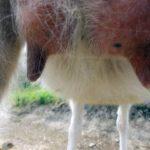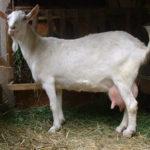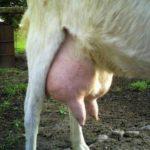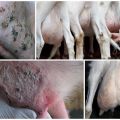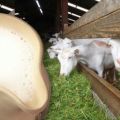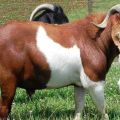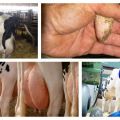Description and structure of the goat's udder, proper care and possible problems
In order to regularly receive high-quality milk, the goat's udder must be well looked after, to prevent inflammatory and infectious diseases. When buying animals, you should pay attention to the structure of the milking organ: it should have an anatomically correct shape with symmetrical teats, without ulcers and cracks. If signs of illness appear on the udder, then you need to contact a veterinarian who will determine the diagnosis and prescribe effective treatment.
Description
The udder is the organ in which the goat accumulates milk. It is important that the milking organ:
- was free from defects;
- had symmetrically located nipples;
- was of the correct form;
- showed no signs of illness or injury.
A goat udder produces milk in the same way as a cow's. The organs of these animals differ insignificantly: in a goat, it consists of two halves separated by an inner membrane, having an autonomous circulatory and nervous system, with a single nipple extending from each. Each half is functionally independent of the other.
Udder device
The udder consists of 3 types of fabrics:
- glandular, in which milk is produced;
- a connective gland that shapes the organ;
- ducts that excrete the formed secret.
Milk synthesis occurs in the alveoli, which make up the glandular tissue. Internal alveolar cells take nutrients from the blood, convert them into liquid for feeding the kids.

A healthy goat has white milk, no blood inclusions. Correctly functioning alveoli, having accumulated a secret, remove it through the ducts after the brain signal. In section, the glandular tissues look like a bluish-red loose mass. The structure of the nipple is simpler: it consists of several skin layers superimposed on each other. The secretory ducts, descending along the nipple, narrow. At the end there is a sphincter that holds a secret, which relaxes when the goat is milked or when the kid is feeding.
It is believed that goats with large udder veins give more milk. In fact, such a feature often indicates the development of varicose veins in an animal.
Nipple shape
Normally, the nipples are oval, symmetrically emerging from the halves, located closer to the front. With a healthy condition and correct structure of milking, the process of obtaining milk takes no more than 5-10 minutes. In goats that give a lot of milk:
- the udder is spherical;
- nipples are not too large;
- the direction of the nipples is vertical and slightly angled;
- nipples are moderately elongated.
You should not buy a goat with a sagging udder and irregularly shaped nipples.She will not give much milk.
Correct care
If the abundance of milk is determined by the shape of the udder, then the quality is determined by the health of the organ and regular care for it. In the diseased organ, milk is formed with a sour taste, a low percentage of lactose and fat. It quickly becomes unusable, unsuitable for the production of dairy products. Caring for the udder of a goat includes 3 mandatory activities:
- Washing before every milking. They use warm water. After the procedure, the udder is thoroughly wiped off with a clean towel. To prevent cracking, you can apply baby cream to your skin.
- Massage is a procedure performed after washing. It helps to improve blood circulation in the tissues, due to which milk is produced more abundantly. Each half of the organ is massaged separately. With hands smeared with cream, lightly rub the halves, then pat, gently crumple. Actions are repeated 5 times.
- Lubrication with vegetable oil is a procedure that allows you to prevent the appearance of cracks and ulcers due to drying out of delicate and sensitive skin.
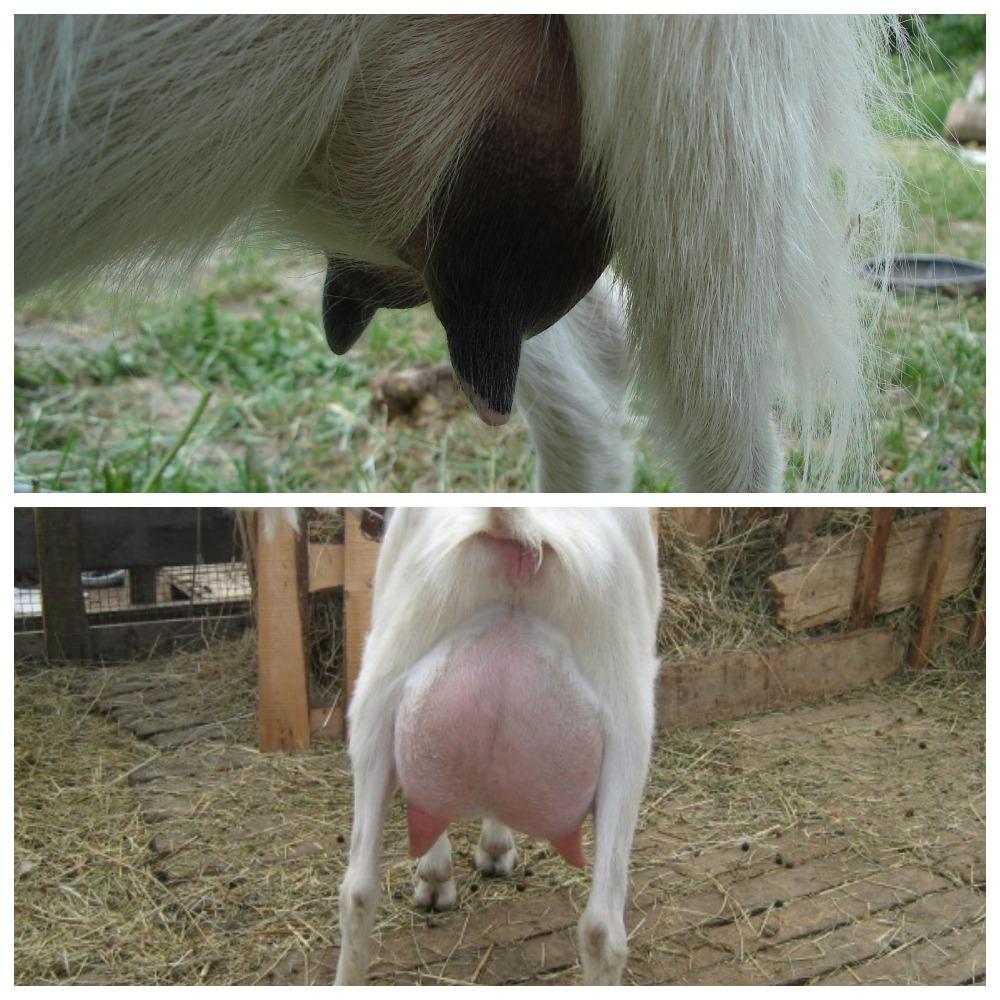
Possible problems
A healthy udder is hairy, the nipples are pink, without bumps, knots, tumors, ulcers, cracks and rashes. Organ diseases are inflammatory, infectious, as well as associated with improper care and maintenance. If the goat has an infection, then it must be isolated from the livestock. Possible diseases of the goat udder:
- Mastitis is an infectious inflammatory disease that occurs either in a milking goat, or when the animal is in a draft, in cold, damp, unsanitary conditions. The udder hardens or partially becomes painful. The milk becomes tasteless, acquires a curdled-watery consistency. In the acute form of the disease, pus is noticeable in the milk, the temperature rises in the goat, and the back of the body swells. An urgent veterinarian is required, and he prescribes antibiotics and topical ointments to relieve symptoms.
- Edema of the mammary glands is a consequence of impaired blood circulation in the capillaries. The problem is often seen in pregnant and giving birth goats. The udder swells, making milking difficult. For prevention, juicy and sour food, salt is removed from the diet of a pregnant goat, and the portion of hay is increased. A secret is milked from the swollen udder every 3 hours, the organ is gently massaged beforehand. And after milking, a therapeutic ointment is applied to restore blood circulation, for example, "Troxevasin".
- Furunculosis is a bacterial pathology, accompanied by the appearance of cone-shaped, pus-filled inflammations. After about a week, the boils rupture, pus comes out, and dry scars remain in their place. You cannot milk a goat: firstly, it is painful for her, and secondly, drinking contaminated milk is dangerous. The causes of infection are non-compliance with sanitary standards in the barn or hypovitaminosis in an animal. The goat is treated with penicillin and streptomycin antibiotics. Closed boils are smeared with ichthyol ointment, the opened ones are sprinkled with streptocide.
- Smallpox is a viral disease accompanied by a febrile condition and rashes in the form of blisters and pustules on all parts of the body. A sick goat refuses to eat, her eyelids swell, and mucus flows from her nose. If there are no complications, then the pet recovers after about 3 weeks. Treatment is symptomatic, iodine, zinc ointment are used. You can drink milk, but only boiled.
- Papillomas are benign neoplasms that resemble warts in humans. They do not bring harm, sometimes they disappear on their own. To remove papillomas, the udder of a goat is lubricated 3 times a day with a product prepared from 10 g of salicylic acid, the same amount of lactic acid and 80 ml of collodion.
Many farmers discard goats born with extra nipples and in vain.This feature is not a defect, but a unique goat can produce a lot of milk. Udder cracks are not uncommon on large farms where sanitary compliance is difficult. Wounds are lubricated with antiseptics and ointments that accelerate healing. Nimble goats can injure the udder. The bruised place is compacted. The temperature of the pet may rise. The problem is not scary: the sore spot is gently massaged, a warm compress is applied to it.
